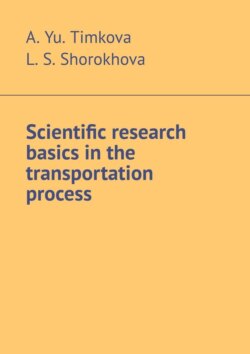Читать книгу Scientific research basics in the transportation process - A. Yu. Timkova - Страница 5
1. Science and its role in the development of society
1.2. Science classification
ОглавлениеScientific disciplines, which in their totality form the system of sciences as a whole, can be very conditionally divided into 3 large groups (subsystems) – natural, social and technical, differing in their subjects and methods. There is no sharp line between these subsystems – a number of scientific disciplines occupy an intermediate position. So, for example, at the junction of technical and social sciences there is technical aesthetics, between natural and technical sciences – bionics, between natural and social sciences – economic geography. Each of these subsystems, in turn, forms a system of separate sciences coordinated and subordinated by subject and methodological connections in a variety of ways, which makes the problem of their detailed classification extremely complex and not completely resolved to this day.
Along with traditional research conducted within the framework of any one branch of science, the problematic nature of the orientation of modern science has given rise to a wide deployment of interdisciplinary and complex research conducted by means of several different scientific disciplines, the specific combination of which is determined by the nature of the corresponding problem. An example of this is the study of environmental problems, which is at the crossroads of technical sciences, biology, earth sciences, medicine, economics, mathematics, etc. Such problems arising in connection with the solution of large farms and social problems are typical of modern science.
According to their orientation, according to their direct relation to practice, individual sciences are usually divided into fundamental and applied. The task of the fundamental sciences is the knowledge of the laws governing the behavior and interaction of the basic structures of nature, society and thinking.
These laws and structures are studied in their “pure form”, as such, regardless of their possible use. Therefore, the fundamental sciences are sometimes called “pure”. The immediate goal of applied sciences is the application of the results of fundamental sciences to solve not only cognitive, but also social and practical problems. Therefore, here the criterion of success is not only the achievement of truth, but also the measure of satisfaction of the social order. At the intersection of applied sciences and practice, a special area of research is developing – developments that translate the results of applied science into the form of technological processes, structures, industrial materials, etc.
Applied sciences can develop with a predominance of both theoretical and practical problems. For example, in modern physics, electrodynamics and quantum mechanics play a fundamental role, the application of which to the knowledge of specific subject areas forms various branches of theoretical applied physics – metal physics, semiconductor physics, etc. Further application of their results to practice gives rise to a variety of practical applied sciences – metallurgy, semiconductor technology, etc., the direct connection of which with production is carried out by the corresponding specific developments. All technical sciences are applied.
As a rule, fundamental sciences are ahead of applied sciences in their development, creating a theoretical reserve for them. Applied science accounts for up to 80—90% of all research and funding in modern science.
One of the urgent problems of the modern organization of science is the establishment of strong, systematic relationships and the reduction of the time of movement within the framework of the cycle “fundamental research – applied research – development – implementation”.
In the Classifier of directions and specialties of higher professional education with a list of master’s programs (specializations) developed by scientific and methodological councils – departments of UMO in the areas of education, the following are highlighted:
1. Natural sciences and mathematics (mechanics, physics, chemistry, biology, soil science, geography, hydrometeorology, geology, ecology, etc.);
2. Humanities and socio-economic sciences (culturology, theology, philology, philosophy, linguistics, journalism, book science, history, political science, psychology, social work, sociology, regional studies, management, economics, art, physical culture, commerce, agroeconomics, statistics, art, jurisprudence, etc.);
3. Engineering sciences (construction, printing, telecommunications, metallurgy, mining, electronics and microelectronics, geodesy, radio engineering, architecture, etc.);
4. Agricultural sciences (agronomy, zootechnics, veterinary medicine, agroengineering, forestry, fisheries, etc.).
The Nomenclature of specialties of scientific workers, approved by the Ministry of Science and Technology of the Russian Federation on January 25, 2000, indicates the following branches of science: physical and mathematical, chemical, biological, geological and mineralogical, technical, agricultural, historical, economic, philosophical, philological, geographical, legal, pedagogical, medical, pharmaceutical, veterinary, art history, architecture, psychological, sociological, political, cultural and earth sciences.
Each of the named groups of sciences can be subjected to further fragmentation. In statistical collections, the following sectors of science are usually distinguished: academic, industry, university and factory.
